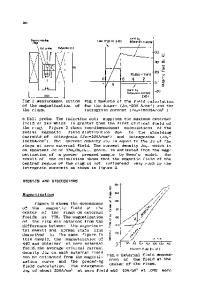Properties of Thin Films of Yba 2 Cu 3 O 7 Prepared by Coevaporation of Y, Cu and Baf 2
- PDF / 244,101 Bytes
- 4 Pages / 420.48 x 639 pts Page_size
- 106 Downloads / 358 Views
PROPERTIES OF THIN FILMS OF YBa 2 Cu 3 O7 PREPARED BY COEVAPORATION OF Y, Cu AND BaF 2 I. D. RAISTRICK, D. W. COOKE, J. G. BEERY, F. H. GARZON, H. JAVADI, M. P. MALEY A. D. ROLLETT, T. ROY, D. N. SINHA, and D. K. WILDE Los Alamos National Laboratory, Los Alamos NM 87545 ABSTRACT The properties of thin films prepared by coevaporation of Y, Cu and BaF 2, followed by post anneals in 0 2 /H 20, are described. In particular, we emphasize what is known about the relationship between the processing variables and the physical and chemical structure of the resulting films. INTRODUCTION Although much more emphasis has been placed in the last year on the preparation of in situ superconducting thin films of YBa 2 Cu 3 O7 , the BaF 2 precursor route, developed by Mankiewich et al.11 has several advantages, if films of the very highest quality are not required. In fact, the properties of the best films prepared by the fluoride route are onlly slightly inferior to in situ films, and the preparation is simple, reliable and fast. In this paper we review the preparation and properties of such films, made by coevaporation of Y, BaF 2 and Cu, on a variety of substrates including SrTiO 3 , LaGaO 3 , and LaAIO 3. DEPOSITION AND ANNEALING The as-deposited films are amorphous, smooth and quite stable in dry air. Because the deposition can be carried out on unheated substrates the process is well suited to lift-off patterning for device fabrication. Deposition rates can be high, since the morphology of the as-deposited films is not particularly important to the quality of the final product.. The as-deposited material is converted to YBa 2Cu 30 7 by a post-depositio I an,,cal at temperatures between 750 and 950 *C. The anneal is carried out in an atmosphere of flowing oxygen, saturated at room temperature with water vapor. The water is thermodynamically essential for the conversion of BaF 2 to an oxide [2]. The influence of temperature and time of the anneal on the properties of the films is discussed in the sections below. COMPOSITION AND PHASE PURITY At higher temperatures (above 800'C) the expected phases are produced, according to the composition and phase diagram. At lower temperatures BaF 2 appears to decompose relatively slowly, leading to effectively Ba-deficient material, favoring the formation of Y2 Ba 4 Cu8 O 20 _-.,. The presence of intergrowths between Y2Ba,,CuO8_0 and YBa 2 Cu3 O7 2o may persist to high temperatures. Y 2Ba 4 CusO 20-. may be stabilized by surface energy contributions or by the presence of F. Impurity phases, such as Y2BaCuO 5 and BaCuO 2 are rejected to the surface of the film, leaving the grain boundaries within the filn very clean [3]. The impurities may be removed from the surface by a short Br 2/ethanol etch [4), which does not appear to significantly degrade the surface properties, as monitored by microwave surface resistance measurements.
Mat. Res. Soc. Symp. Proc. Vol. 169. c1990 Materials Research Society
696
ORIENTATION AND MICROSTRUCTURE The films grow with an unusual duplex microstructure. Next
Data Loading...











